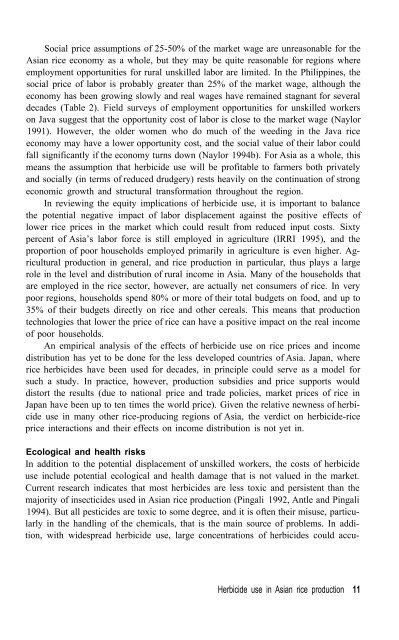HERBICIDES in Asian rice - IRRI books - International Rice ...
HERBICIDES in Asian rice - IRRI books - International Rice ...
HERBICIDES in Asian rice - IRRI books - International Rice ...
You also want an ePaper? Increase the reach of your titles
YUMPU automatically turns print PDFs into web optimized ePapers that Google loves.
Social p<strong>rice</strong> assumptions of 25-50% of the market wage are unreasonable for the<br />
<strong>Asian</strong> <strong>rice</strong> economy as a whole, but they may be quite reasonable for regions where<br />
employment opportunities for rural unskilled labor are limited. In the Philipp<strong>in</strong>es, the<br />
social p<strong>rice</strong> of labor is probably greater than 25% of the market wage, although the<br />
economy has been grow<strong>in</strong>g slowly and real wages have rema<strong>in</strong>ed stagnant for several<br />
decades (Table 2). Field surveys of employment opportunities for unskilled workers<br />
on Java suggest that the opportunity cost of labor is close to the market wage (Naylor<br />
1991). However, the older women who do much of the weed<strong>in</strong>g <strong>in</strong> the Java <strong>rice</strong><br />
economy may have a lower opportunity cost, and the social value of their labor could<br />
fall significantly if the economy turns down (Naylor 1994b). For Asia as a whole, this<br />
means the assumption that herbicide use will be profitable to farmers both privately<br />
and socially (<strong>in</strong> terms of reduced drudgery) rests heavily on the cont<strong>in</strong>uation of strong<br />
economic growth and structural transformation throughout the region.<br />
In review<strong>in</strong>g the equity implications of herbicide use, it is important to balance<br />
the potential negative impact of labor displacement aga<strong>in</strong>st the positive effects of<br />
lower <strong>rice</strong> p<strong>rice</strong>s <strong>in</strong> the market which could result from reduced <strong>in</strong>put costs. Sixty<br />
percent of Asia’s labor force is still employed <strong>in</strong> agriculture (<strong>IRRI</strong> 1995), and the<br />
proportion of poor households employed primarily <strong>in</strong> agriculture is even higher. Agricultural<br />
production <strong>in</strong> general, and <strong>rice</strong> production <strong>in</strong> particular, thus plays a large<br />
role <strong>in</strong> the level and distribution of rural <strong>in</strong>come <strong>in</strong> Asia. Many of the households that<br />
are employed <strong>in</strong> the <strong>rice</strong> sector, however, are actually net consumers of <strong>rice</strong>. In very<br />
poor regions, households spend 80% or more of their total budgets on food, and up to<br />
35% of their budgets directly on <strong>rice</strong> and other cereals. This means that production<br />
technologies that lower the p<strong>rice</strong> of <strong>rice</strong> can have a positive impact on the real <strong>in</strong>come<br />
of poor households.<br />
An empirical analysis of the effects of herbicide use on <strong>rice</strong> p<strong>rice</strong>s and <strong>in</strong>come<br />
distribution has yet to be done for the less developed countries of Asia. Japan, where<br />
<strong>rice</strong> herbicides have been used for decades, <strong>in</strong> pr<strong>in</strong>ciple could serve as a model for<br />
such a study. In practice, however, production subsidies and p<strong>rice</strong> supports would<br />
distort the results (due to national p<strong>rice</strong> and trade policies, market p<strong>rice</strong>s of <strong>rice</strong> <strong>in</strong><br />
Japan have been up to ten times the world p<strong>rice</strong>). Given the relative newness of herbicide<br />
use <strong>in</strong> many other <strong>rice</strong>-produc<strong>in</strong>g regions of Asia, the verdict on herbicide-<strong>rice</strong><br />
p<strong>rice</strong> <strong>in</strong>teractions and their effects on <strong>in</strong>come distribution is not yet <strong>in</strong>.<br />
Ecological and health risks<br />
In addition to the potential displacement of unskilled workers, the costs of herbicide<br />
use <strong>in</strong>clude potential ecological and health damage that is not valued <strong>in</strong> the market.<br />
Current research <strong>in</strong>dicates that most herbicides are less toxic and persistent than the<br />
majority of <strong>in</strong>secticides used <strong>in</strong> <strong>Asian</strong> <strong>rice</strong> production (P<strong>in</strong>gali 1992, Antle and P<strong>in</strong>gali<br />
1994). But all pesticides are toxic to some degree, and it is often their misuse, particularly<br />
<strong>in</strong> the handl<strong>in</strong>g of the chemicals, that is the ma<strong>in</strong> source of problems. In addition,<br />
with widespread herbicide use, large concentrations of herbicides could accu-<br />
Herbicide use <strong>in</strong> <strong>Asian</strong> <strong>rice</strong> production 11

















